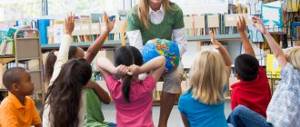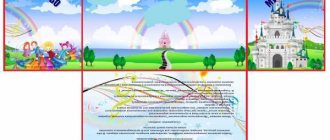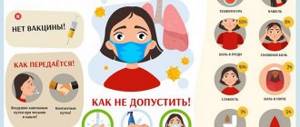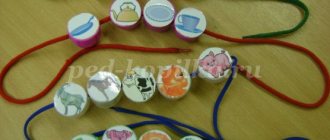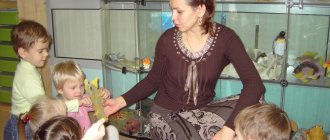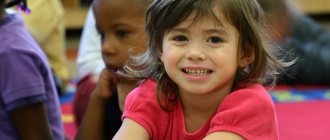Health-saving technologies - what is it?
What are health-saving educational technologies (HET)?
The founder of this concept was N.K. Smirnov, who gave the following definition: “This is a set of forms and techniques for organizing the educational process without harming the health of the child and the teacher.”
In practice, such technologies include those that meet the following requirements:
- Create normal conditions for learning at school (lack of stress for the child, creation of a friendly atmosphere, adequacy of the requirements for the child).
- Take into account the age capabilities of the child. That is, when distributing physical and educational activity, age is taken into account.
- They rationalize the organization of the educational process (in accordance with the psychological, cultural, age, gender, and individual characteristics of each child).
- Provide sufficient motor mode.
From the experience of work “Health-saving technologies in primary schools”
“The use of health-saving technologies in elementary school”
(from work experience)
Health is an invaluable asset not only for every person, but also for the entire society. Recently, the catastrophic deterioration in the health of students has become more obvious. Along with unfavorable social and environmental factors, the negative impact of school on children’s health is also recognized as a reason.
Research in recent years shows that about 25–30% of children entering 1st grade have some kind of health problem. During the period of children's education at school, the number of healthy children decreases by 4 times, the number of myopic children increases from 1st grade to graduation from 3.9 to 12.3%, with neuropsychic disorders - from 5.6 to 16.4%, violation posture_ from 1.9 to 16.8%. One of the most common pathologies among schoolchildren is impaired visual acuity, which amounts to 30-40% in a number of regions of Russia.
The foundation of health is laid in childhood, and this is a concern not only for doctors. Human health depends: • 50% on lifestyle; • 25% - on the state of the environment; • 15% - from the inheritance program; • 10% - from the capabilities of medicine. (according to research by the World Health Organization).
But the “school factor” is the most significant factor in terms of influence and duration that influences the health of children. Currently, the earlier start of systematic training and significant intensification of the educational process have led to an increase in the educational load on the functional capabilities of the children's body.
I have been working in an elementary school for a long time and, having analyzed the health indicators of my students, I can confirm the above. Thus, we are faced with the task of preserving and strengthening the health of students after entering school, when the psychological and physical stress on the child’s body increases.
The concept of modernization of Russian education involves the development of a new model of primary school that meets the current and future needs of the individual, society and the state. One of them is the health of the younger generation. This is an important indicator of the well-being of society. And although it is traditionally believed that the main task of the school is to provide the necessary education, an equally important task is to preserve the health of children during the learning process. The success of education is also related to the state of health. All this requires careful attention to the organization of school life: creating optimal hygienic, environmental and other conditions, ensuring the organization of the educational process, preventing the formation of overwork in students. Considering the above, in my work I adhere to a health-saving organization of the educational process.
Types of health-saving technologies that I use in my work: - Medical - preventive - they ensure the preservation of children's health under the guidance of health workers; - Physical education - health - they are aimed at physical development and health promotion: the development of physical qualities, motor activity - Health-saving educational - these are, first of all, technologies for nurturing a valeological culture or a health culture for schoolchildren. The purpose of this technology is to develop a child’s conscious attitude towards health, to accumulate knowledge about health, and to develop skills to protect, maintain and preserve health. The leading principle of these technologies is taking into account the child’s personal characteristics, the individual logic of his development, taking into account children’s interests and preferences in content and types of activities. — Technology to ensure the social and psychological well-being of the child. This technology ensures the mental and social health of the child. The main objectives of this technology are to ensure emotional comfort and positive well-being, psychological well-being in the process of communicating with peers, adults, at school, and family. — Technology of valeological education of parents and students - the task of this technology is to ensure valeological education of parents of students.
— Gaming technologies — the use of gaming technologies in the educational process.
— Personally-oriented training.
Health preservation and health enrichment are important conditions for organizing the pedagogical process.
I determine the goals and objectives of upcoming activities based on the choice of technologies used.
Target:
provide the student with the opportunity to maintain and improve health while studying at school.
Objectives:
- organizing work with the greatest effect to preserve and strengthen health; — creating conditions for children to feel joy during the learning process; — teach children to live in harmony with themselves and the world around them; — fostering a culture of health; — development of creative abilities; — motivation for a healthy lifestyle; — teach children to use the acquired knowledge in everyday life; — introduction of innovative pedagogical technologies;
The educational complex “School 21st Century” (the educational complex in which I work now) and the educational complex “School of Russia” (the educational complex in which I worked previously) help to introduce health-saving technologies based on a person-oriented approach to training and education.
Health conservation in the classroom.
The student spends most of his time at school in class. Therefore, the most important task remains the organization of the lesson.
in conditions of health-saving technology.
A well-didactically designed lesson is the most health-oriented for all its participants. A healthy student is happy to participate in all types of activities, he is cheerful, optimistic, and open in communication with peers and teachers.
The beginning of schooling is associated not only with changes in children’s lifestyle, but also with a sharp increase in loads on the child’s individual organs. A 30-minute lesson duration best suits the physiological capabilities of the body for first-grade students. For students in grades 2–4, a combined lesson is recommended using 5–10 minutes to relieve fatigue, including activities such as a dynamic pause, learning physical exercises, and others. Undoubtedly, the best methods of maintaining efficiency in the lessons is to change the forms of student work. Taking into account the age-related psychological characteristics of younger schoolchildren, I think through the number of types of learning activities in the lesson, avoid monotony so that rapid fatigue does not set in. (Student survey, writing, reading, listening, telling a story, looking at visual aids, answering questions, solving problems. The norm is 4-7 types per lesson.).
Of all the loads that a child encounters at school, the most tiring is the load associated with the need to maintain a working posture. Therefore, I try not to require students to maintain a stationary body position throughout the lesson. Switching during a lesson from one type of activity to another must inevitably be accompanied by a change in the child’s posture.
The child’s main workplace at school is a desk, at which he has to sit for a long time in an inclined position, which can lead to poor posture, weakened vision, and numb legs. To avoid such consequences, every week I move the children from one desk to another, from row to another row.
I think through techniques that make it possible to activate the students themselves in the process of mastering new knowledge, I try to predict several possible options for the development of educational events, depending on the situation created in the class.
Overload of students in the lesson, which causes an increase in the level of fatigue and nervousness, depends not so much on the quantity as on the quality of work. If the process of acquiring knowledge is interesting and motivated, then mastering the material will not create an overload effect. Conversely, what causes students rejection or seems unpromising, meaningless and aimless leads to overload even with relatively small amounts of material. From the above it follows that the educational process should be creative. By including the child in the creative process, the search for solutions serves human development and reduces the onset of fatigue. Students act as researchers or teachers. With a creative approach to learning, each child receives only positive emotions from the lesson, which arouses special interest in learning.
This is achieved using:
- game situations in lessons, different forms of lessons (KVN, quizzes, fairy tales, games); - dramatization of dialogues with movement, acting out scenes of literary plots; - outdoor games during breaks;
— ICT tools;
— design and research activities;
- conducting physical exercises for students;
— visibility; — entertaining exercises; - fantasizing;
-conducting fragments of lessons; - creative nature of homework (compose a task, for example, draw an illustration for a work, come up with a riddle on a topic, including design and research activities using ICT).
I help each child realize their abilities, create conditions for their development, which helps maintain and strengthen the child’s health. All this contributes to the development of communication skills, motor activity, concentration, imagination, cognitive abilities, reduces psycho-emotional stress, increases interest in lessons, helps the development of correct self-esteem or its correction towards improvement.
I use various methods in my lessons that promote the activation of initiative and creative self-expression of the students themselves, and a high level of health conservation.
The presence and place of methods that promote activation: the method of free choice (free conversation, choice of method of action, freedom of creativity); active methods (student in the role of teacher, researcher, business game, discussion); methods aimed at self-knowledge and development (intelligence, emotions, communication, self-esteem, mutual esteem).
The emotional climate in the lesson is important: • “A good laugh gives health”; • Majority of the lesson; • Emotional motivation at the beginning of the lesson; • Creating a situation of success.
The teacher’s communication style with students also affects the health of schoolchildren, their activity or passivity in the classroom. I prefer to use a democratic style of communication, which creates conditions for the development of the child’s mental activity, gives freedom of cognitive activity, the student is not afraid to make mistakes when solving the task. The student, being in a state of mental comfort and security, enjoys working in class.
Using a computer in the classroom increases the intensity of learning and enhances the individualization of the educational process. Visualization, the ability to change the pace and forms of studying the material, its figurative and artistic presentation - all this makes the computer an indispensable teacher's assistant in reducing student fatigue.
In my lessons, I try to use health-saving elements as often as possible. For example, I teach mathematics lessons in the form of excursions. Educational excursions as a form of lesson provide health-preserving education, since they eliminate the negative factors of school life. For example, “Spatial relationships: above - below, above - below. Comparison of objects", "Number and figure 4. Composition of the number 4", "Units of length", "Numbering. Even and odd numbers", "Parts of figures". I systematically conduct gaming lessons. After all, play is the most effective type of activity in the student-teacher chain, allowing the child to remain productive for as long as possible. In games, children enter into various relationships: cooperation, subordination, mutual control, etc. After all, it’s no secret that using a game, a teacher reveals great potential, subordinating the rules of the game to his educational and educational tasks. For example, “Getting to know the letter Y”, “Get ready to exercise”!; We met,” “The Journey of a Droplet.”
Lessons about the surrounding world take the form of lessons - observations: for example, lessons - workshops: “Healthy food”, health lessons: “If you want to be healthy, toughen up!” (such lessons are entirely devoted to the topic of health), research lessons: “What types of water are there?” “Healthy food”, lessons - searches: “Wintering birds”, lessons - excursions “What did autumn give us?”
The topics of lessons about the surrounding world are rich soil for engaging in project activities with students: mini-projects on the topic “Maintaining Health.” For example, “Healthy eating”, “Daily routine”, “Dental care”.
To solve the problem of preserving the health of children, I update the design of the classroom every year, involve children in the design of health corners; I organize exhibitions of drawings on the topic “Health” in the classroom based on the works I have read; I select the soundtrack for the lessons - “Sounds of Nature”, classical pieces of music. In my lessons I constantly work with color, actively using colored crayons, colored sponges, and isotherapeutic compositions. Children, on the advice of the teacher, get not a smooth, but a ribbed fountain pen - when their fingers get tired, they can roll it between their palms. In elementary schools there are special simulators, “Hedgehogs”. During lessons, children are recommended to use colored pens and pencils, which is a compensating remedy for children’s fatigue.
Differentiated learning is practically implemented through the content of textbooks and notebooks, which make it possible to remove difficulties for weak students and create favorable conditions for the development of strong students.
For slow children, I reduce the pace of the questioning, do not rush the student, give time to think, prepare, and create conditions so that his activities correspond to his individual pace.
Physical exercises, exercises, massage minutes
Lack of physical activity is one of the reasons for the decrease in the adaptive resources of a schoolchild’s body. Physical education exercises affect brain activity, activate the cardiovascular and respiratory systems, improve blood supply to internal organs and the performance of the nervous system.
But you need to approach the physical minute creatively, trying in every possible way to diversify this event. For example, “revive” the lesson emotionally or use a game (in groups, in pairs, at the blackboard) to move children around the class. Alternately entrust physical education to the children themselves. Teach children to use the necessary set of exercises for self-relaxation in class at school and at home.
The start time of physical education is chosen by the teacher himself (approximately 20 minutes from the start of the lesson) or with the development of the first phase of mental fatigue in a significant part of the students in the class (phase of motor restlessness). Such work is necessary to increase the mental performance of children and relieve their statistical muscle tension.
Requirements: - they must be varied; - carried out at the initial stage of fatigue; - give preference to exercises for tired muscle groups.
Carrying out physical education minutes: * relaxation of the hands; * finger massage before writing; * breathing exercises; * prevention of eye fatigue.
*motor training;
*games We start every working day in class with gymnastics, which lasts about five minutes. There are presentations for children for eye gymnastics. There are also interesting animated presentations for relaxing parts of the body. I try to select exercises depending on the specifics of the lesson. Tension of various muscle groups is associated with performance. When the hand gets tired, the child gets tired. Example:
"Cabbage". Movements, imitation of actions. We chop cabbage. We are three cabbage. We salt the cabbage. We are pressing cabbage.
The teacher’s task: to teach how to write without straining your hand, which means saving energy. Example:
Massage your fingers before writing. - wiping palms; "Rolling pin."
- roll the handle between your palms; - roll the pen between your thumb and index finger; "Playing the Keys"
Take turns tapping certain fingers of both hands on the desk. For foot massage, we plan to make homemade massage mats with the parents of first-graders, modeled after Kuznetsov’s applicator from scrap material: for first and second grades - from sewn buttons, and for third and fourth grades - from plastic bottle caps. Use the “Palms” play wall to develop your hands. Children's palms are painted on the wall from floor to wall. The child reaches the upper palms by standing on tiptoes and stretching his arms as high as possible. This corrects posture and curvature of the spine, relieves fatigue in the muscles of the hands and promotes their development. The child’s speech abilities are developed through labor training lessons. Much attention is paid to this in extracurricular activities. I have compiled the “Miracle – Master” program. A health mindset does not appear by itself, but is formed as a result of pedagogical influence. In free play, creative activity, through practical actions, the motivational basis of hygienic, sexual and moral education is brought up.
Motor training without the use and with the use of various improvised means (erasers, books, plastic bags, pieces of cotton wool, scarves, yogurt cups, etc.) are very captivating for children, contribute to good physical and emotional release and, accordingly, fruitful work at the lesson.
Ecological space in the classroom
Preserving the health of students is also facilitated by the presence
ecological space, which implies: a) ventilation of premises; c) landscaping of the office; d) office lighting.
Smells have a beneficial effect on health and mood. Their best source is plants, our silent friends and helpers. Parents assist in landscaping the classroom. The program of extracurricular activities “Miracle Masters” involves practical activities in caring for flowers, project activities: the environmental project “Green Friend” (growing a flower), growing seedlings for the garden. In addition, the educational task of involving children in caring for plants is solved, and the foundations of environmental education are laid.
Extracurricular activities, class hours
Classes on the topic of health were and are held monthly. We actively participate and have taken part in school events dedicated to health (Health Days, “Path of Survival,” “Zarnitsa,” “Cross of Nations,” “Mom, Dad, I am a Sports Family.” Poster competitions, health events).
I conduct and have conducted extracurricular classes “Hour of Health”, in which a lot of pedagogical, medical and psychological techniques have been tested and implemented, aimed at preserving and strengthening the child’s health, and his social adaptation. “Health Hour”: children actively participated in sporting events: “Book of Class Records”, “My Fun Tinkling Ball”, “Small Olympic Games in the Classroom”, “Me and My Car”, “Yogurt Hour”, etc. Results for each competition are entered into the “Portfolio of Personal Achievements”, which each student has (see at the end). Children received awards for winning each competition. A course “Health Lessons” was conducted, where students learned the laws of a healthy lifestyle (the program “Pedagogy of Health” was used, edited by Kasatkin, M., 2000).
Parents are interested helpers
Work to strengthen and preserve the health of students is impossible without the involvement of parents, since good communication between the school and parents is a fundamental condition in student-centered education. Parents become participants in class hours (“Daily routine”, “Lessons from Moidodyr”, “The most important value”).
One of the most important tasks assigned to parents is monitoring the student’s daily routine and balanced nutrition. Where these tasks are solved successfully, a healthy, physically strong child with a good emotional and volitional sphere, socially protected, grows up in the family.
For many years, parents have been participating with great pleasure in sports festivals, theatrical performances, New Year’s matinees, themed “Harvest Festival” matinees, extracurricular activities in the subjects: KVN, savvy tournaments, “Star Hour”, etc.
Parents provide seeds for their children. A child who plants plants with his own hands and takes care of them grows in his soul the sprouts of kindness, mercy, love for all living things, and develops an ecological culture.
Classes, health lessons, sporting events, hikes, excursions into nature help the child develop a moral attitude towards his health, which is expressed in the desire and need to be healthy and lead a healthy lifestyle.
The work of health workers to preserve the health of students.
In my work, I take into account the testimony of health workers who conduct explanatory work with parents and teachers to preserve the health of the child.
Meals at school.
A healthy lifestyle also means proper nutrition. Another important aspect of health is nutritional culture.
The best diet for a healthy person is food low in cholesterol, sugar, salt, high in macro- and microelements, vitamins, and protein in a reasonable combination.
Meals at school are clearly balanced; every day students receive a vegetable salad (beets, carrots, cabbage), first or second course (potatoes, cabbage, cereals, meat) for lunch. All vegetables are grown with our own labor in the summer.
Self-management and health preservation
The problem of health conservation has become a concern not only for primary school teachers, but also one of the issues of school self-government. Every year, a sports mayor is elected in the class, who is responsible for physical education and recreational work in the class (of course, the teacher helps the sports mayor in this work as needed). The main direction of his activity is the development, together with physical education teachers, of sets of health-improving exercises, selection of physical exercises, exercises before class, planning and holding sports events (“Health Day”, Physical Education Olympiad, competitions “Fun Starts”, “Great Races”, etc. .), conducting lessons (fragments). Children like to show independence when conducting physical exercises, fragments of lessons, and activities in the classroom (see CD Appendix 6).
The surrounding nature for health protection.
Living in the countryside, we have a rich opportunity to be in nature more often, communicate with it and receive not only pleasure from it, but also benefits for our health.
Conclusion
Including health-saving technologies in the lesson allows you to create an atmosphere of a “healthy” lesson. I have developed the main directions for improving the health of students:
– it is recommended to conduct training sessions in classes in dynamic pause mode. For this purpose, physical education sessions are held in classes, which are accompanied by funny poems, musical excerpts from popular children's songs;
– carrying out a set of exercises for motor gymnastics of the eyes, which allows strengthening the eye muscles;
- a creative approach to the lesson with the aim of preserving health;
- holding a “Health Hour”;
-conducting motor training in class;
- conducting classes on health topics;
- valeological education of parents on health issues;
-involving parents in participating in health-related activities;
-following the recommendations of medical workers;
-maintaining the ecological space of the classroom.
One of the directions is the introduction of modern health-saving technologies into the learning process for junior schoolchildren. One of them is well known: these are integrated lessons. Teachers are turning to this form of work more and more often, starting from grade 1: literacy + writing, familiarization with the outside world + labor training or fine arts, natural history + reading, reading + Russian language.
Further down, see the appendix.
Basic principles of health conservation in primary and secondary schools
The principles were formulated by N.K. Smirnov.
- "Do no harm"
- Taking care of the health of the teacher and the child is a priority.
- Continuity. That is, work to preserve and protect health should not be carried out occasionally, but constantly, comprehensively.
- Age appropriate learning content.
- Success breeds success. That is, neutralizing everything negative and emphasizing positive factors.
- Responsibility. The teacher should strive to instill in the child responsibility for his own health.
Classification of health-saving technologies
Specialists developing this area of methodology offer several classifications of health-saving technologies that take into account different aspects. The most general classification looks like this:
- Technologies that provide hygienically optimal learning conditions.
- Technologies for teaching a healthy lifestyle.
- Psychological and pedagogical technologies used by teachers in class and extracurricular activities. This refers to the teacher’s influence on students at every stage of the lesson and during extracurricular activities.
- Corrective technologies.
Fifteen health-saving technologies for school
- A physical education minute is a dynamic pause during intellectual activities. It is carried out as children become tired. This could be breathing exercises, eye exercises, or light physical exercises. Time - 2-3 minutes.
- Finger gymnastics - used in lessons where the student writes a lot. This is a short warm-up for your fingers and hands.
- Gymnastics for the eyes . Conducted during intellectual activities. Time - 2-3 minutes.
- Changing types of activities is the expedient alternation of different types of activities in the lesson (oral work, written work, game moments, etc.). It is carried out with the aim of preventing rapid fatigue and increasing the interest of students.
- Articulation gymnastics . This includes work on speech development, counting rhymes, rhythmic poems, oral retellings, choral repetitions, which are used in lessons not only for mental, psychological and aesthetic development, but also to relieve emotional stress.
- Games . Any kind of games: didactic, role-playing, business - games are designed to solve not only educational problems. At the same time, they develop creative thinking, relieve stress and increase students’ interest in the learning process.
- Relaxation - carried out during intellectual activities to relieve tension or prepare children to perceive a large block of new information. This could be listening to calm music, sounds of nature, or mini-auto-training.
- Aesthetic technologies . This includes going to museums, visiting exhibitions, working in clubs, that is, all activities that develop the child’s aesthetic taste.
- Office decoration . The sanitary and hygienic condition of the premises in which classes are held is also considered a health-saving technology. This takes into account not only cleanliness, but also temperature, fresh air, the presence of sufficient lighting, and the absence of sound and other stimuli.
- Students' poses . If in elementary school teachers still monitor the posture and correct position of the child at the desk while writing or reading, then in high school this is often neglected. At the same time, posture is formed in a person only by the age of 15-17 years. And incorrect postures that a child takes during lessons can lead not only to poor posture, but also to rapid fatigue, wasted energy, and even illness.
- Technologies that create a positive psychological climate in the classroom. This includes not only methods and techniques that increase motivation, but also techniques that teach teamwork, attentiveness, improve the microclimate in the team, and promote personal growth and self-esteem.
- Emotional releases are mini-games, jokes, moments of humor, entertaining moments, in general, everything that helps relieve tension under heavy emotional and intellectual stress.
- Conversations about health . In addition to the mandatory life safety and physical education courses, one should strive to ensure that the lessons in one form or another address issues related to health and attracting people to a healthy lifestyle. It is most convenient to do this in the practical part of the lessons, deliberately simulating situations related to health and safety. For example, in Russian language lessons you can choose texts related to a healthy lifestyle for exercises and dictations.
- Communication style between teacher and students. Modern standards require teachers to be democratic and tactful. The most important thing is to provide the student with mental comfort and a sense of security, which will allow him to study with pleasure, and not under duress.
- Working with parents . The continuity of the operation of the PTA cannot be monitored without the participation of parents. They are the ones responsible for maintaining the daily routine, diet, and monitoring the child’s physical health. Conversations during class hours, speeches by medical workers at parent-teacher meetings—this also applies to health-saving technologies.
This is a list of only the most popular and generally available health-saving technologies that any subject teacher can use during the organization of the educational process.
Health-saving technologies in primary school lessons
Being a creative person by nature, she not only studied the provisions of V.F. Bazarny’s health-saving technology, the experience of teachers already using this technology, tested it in her practice, but also “invented” her own techniques, which also work to preserve and improve the health of children. Greater mobility of children in the lesson was achieved thanks to the techniques that I developed.
Children are looking for answers to questions posed by the teacher, and the answers are “hanged” in different parts of the class at different levels from the floor. To find the right answer, the child either has to turn his head in different directions, or run around the class (1st row - term, 2nd row - another term. The teacher gives the command: “1st term is collected near the board” - children 1 of the 1st row run to the board. “The 2nd term is collected near the door” - the children of the 2nd row run to the door. “Everyone run to me!” All the children run to the teacher. “What did you get?” Children: “Sum ")
Or, children are given cards with numbers (for example, on the topic sum), they need to group in groups of three so that one has one term, the other has another term, and the third has the sum of these terms.
During the lessons, we systematically worked with children according to the scheme of universal symbols (“USS”) in different modes. At each lesson, physical education lessons were held, the environment for which was constantly changing: between desks, with poetry, with music. At each lesson there was mandatory gymnastics for the eyes (also varied: either they look for something with their eyes without turning their heads, or they use the landscape outside the school window, etc.). (Appendix 2) Breathing exercises were often used.
She worked in constant collaboration with a medical professional. With their help, parents were educated on this issue and familiarized with diagnostic results.
Parents became more active: they themselves were interested in the progress of the experiment, the results, and offered help if necessary. At parent meetings, they provided information about the well-being of their children at home and shared their impressions. Together with the teacher, we discussed problems, some nuances that arose during the experiment, and looked for ways to solve them.
As a result of the experiment, the active position of parents in relation to health increased, the percentage of “not sick” children increased to 40% and the number of lessons missed due to illness per student decreased to 6%. (Annex 1)
Conclusion
In accordance with the objectives set in this study, the following tasks were solved: the literature was studied and analyzed, modern health-saving technologies used in elementary schools were studied; an experimental study of the health status of elementary school students was conducted; health-saving technologies were selected and tested in lessons in 1st grade.
